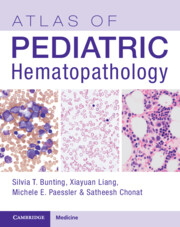Book contents
- Atlas of Pediatric Hematopathology
- Atlas of Pediatric Hematopathology
- Copyright page
- Contents
- Contributors
- Section I Peripheral Blood
- Section II Normal and Non-neoplastic Hematolymphoid Diseases
- Chapter 5 Benign Non-neoplastic Noninfective Lymphadenopathy
- Chapter 6 Normal Bone Marrow Components in Pediatric Patients
- Chapter 7 Infectious Diseases
- Section III Mature Lymphoid Neoplasm
- Section IV Precursor Hematopoietic Neoplasms and Related Neoplasms
- Section V Histiocytic Neoplasm and Miscellaneous Bone Marrow Diseases
- Index
- References
Chapter 7 - Infectious Diseases
from Section II - Normal and Non-neoplastic Hematolymphoid Diseases
Published online by Cambridge University Press: 25 November 2023
- Atlas of Pediatric Hematopathology
- Atlas of Pediatric Hematopathology
- Copyright page
- Contents
- Contributors
- Section I Peripheral Blood
- Section II Normal and Non-neoplastic Hematolymphoid Diseases
- Chapter 5 Benign Non-neoplastic Noninfective Lymphadenopathy
- Chapter 6 Normal Bone Marrow Components in Pediatric Patients
- Chapter 7 Infectious Diseases
- Section III Mature Lymphoid Neoplasm
- Section IV Precursor Hematopoietic Neoplasms and Related Neoplasms
- Section V Histiocytic Neoplasm and Miscellaneous Bone Marrow Diseases
- Index
- References
Summary
Lymphadenopathy (LAD) refers to the enlargement and/or abnormal consistency of lymph nodes and may be localized or diffuse. It reflects the results of immune responses to different insulants such as infection, autoimmunity, or malignancy [1]. Children with LAD are much more likely to have benign etiologies than adults, and most commonly present with a cervical mass [2]. While most benign LADs in children have no identifiable cause and are defined as nonspecific reactive LAD, some cases are found to be of infectious origin, including bacteria, yeast, parasite, or virus, often referred to as lymphadenitis [3].
- Type
- Chapter
- Information
- Atlas of Pediatric Hematopathology , pp. 52 - 64Publisher: Cambridge University PressPrint publication year: 2023



